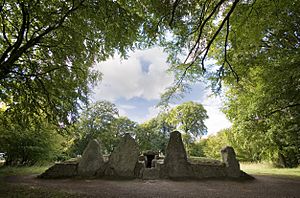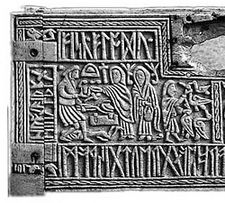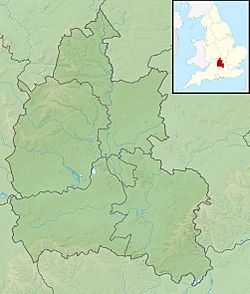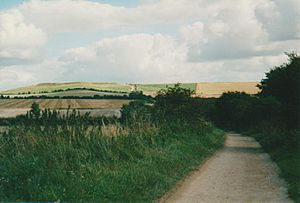Wayland's Smithy facts for kids

The long barrow entrance
|
|
| Location | Near Ashbury |
|---|---|
| Region | Oxfordshire England |
| Coordinates | 51°34′00″N 1°35′46″W / 51.5667811°N 1.5961466°W |
| Type | long barrow and chamber tomb |
| History | |
| Periods | Neolithic |
| Site notes | |
| Excavation dates | 1962–63 |
| Archaeologists | Stuart Piggott |
| Condition | Restored |
| Public access | Yes |
| Website | English Heritage |
| Official name | Wayland's Smithy chambered long barrow, including an earlier barrow and Iron Age and Roman boundary ditches |
| Designated | 1882 |
| Reference no. | 1008409 |
Wayland's Smithy is an ancient burial mound in Oxfordshire, England. It's called a chambered long barrow. People built it around 3600 BC, during the Early Neolithic period in Britain. Today, parts of it have been rebuilt.
Archaeologists believe that early farming communities built this monument. These communities had just started using agriculture in Britain. Wayland's Smithy is part of a larger group of similar burial mounds. These are found across Europe and are known as the Cotswold-Severn Group. Wayland's Smithy is one of the best-preserved examples.
The mound was originally about 56 meters (185 feet) long and 13 meters (43 feet) wide. Its current look comes from restoration work done in the 1960s. Archaeologists Stuart Piggott and Richard Atkinson led this work. They found that the site was built in two main stages. First, a wooden burial chamber was built around 3590-3550 BC. Later, a stone chambered long barrow was added around 3460-3400 BC.
Wayland's Smithy is located near other famous ancient sites. These include the Uffington White Horse and Uffington Castle. It is also close to The Ridgeway, an ancient road. In the early Middle Ages, people started linking the site to a mythical figure. This was Wayland the Smith, a legendary metal-worker. That's how the site got its name. Today, different modern Pagan groups use the site for their rituals. English Heritage looks after Wayland's Smithy. It is a protected ancient monument and is free for visitors to explore.
Contents
What is a Long Barrow?
The Early Neolithic period was a time of big changes in Britain. Between 4500 and 3800 BC, people started farming instead of hunting and gathering. This new way of life came from other parts of Europe. It's not fully clear if new people arrived or if local Britons learned farming techniques.
Long barrows like Wayland's Smithy were important burial places. They were often used by early farming communities. These large mounds show how people honored their dead long ago.
Exploring Wayland's Smithy
The first burial site at Wayland's Smithy had a wooden chamber. It had a stone floor and two big posts. Archaeologists found one body placed in a crouched position. They also found parts of 14 other bodies scattered around. These remains suggest that bodies were left out to decay before burial. This process is called excarnation.
Later, a stone tomb was built over the wooden one. This stone tomb has a special shape, like a cross. At the entrance, there are four large sarsen stones. Originally, there were six of these huge stones. These stones were put back upright after the 1962 excavations. Archaeologists call this type of tomb a Severn-Cotswold tomb. A large, trapezoid-shaped earth mound covered the stone tomb. This mound had a stone edge and was built from earth dug from two ditches. In 1919, excavations found the remains of seven adults and one child inside.
This site is important because it shows a change in burial styles. It went from a wooden chamber to a stone one in a short time. The burials in the second tomb are from a later period for this type of burial.
The Legend of Wayland the Smith

The name "Wayland's Smithy" comes from a mythical metal-worker named Wayland the Smith. This character is famous in Norse mythology. You can even see a picture of him on the Franks Casket at the British Museum in London. The name "Wayland's Smithy" was first written down in a land document from 955 AD. This was about 4,000 years after the mound was built! The Saxons who settled in the area likely gave it this name.
In 1738, a man named Francis Wise wrote down a local story about the site. People believed that an invisible smith lived there. If a traveler's horse lost a shoe, they could leave the horse and some money at the site. When they came back, the money would be gone, but the horse would have new shoes!
The site was also mentioned in a letter in 1758 and in Walter Scott's novel Kenilworth in 1821. The name "Wayland Smith's Forge" appeared on a map in 1828.
Modern Traditions at the Site
People have been leaving coins at Wayland's Smithy since at least the 1960s. Visitors often push coins into cracks in the stones. The local wardens from The National Trust now remove these coins. They donate the money to local charities. This tradition adds to the site's long history of stories and beliefs.
Some modern Pagan groups use Wayland's Smithy for their ceremonies. These include different Druids. They find the site important because of its link to Wayland and its history as a burial ground. These groups see it as a place to connect with "ancestors" and "earth spirits."



